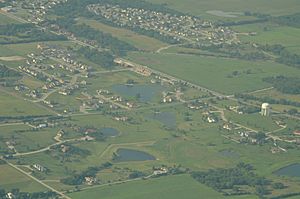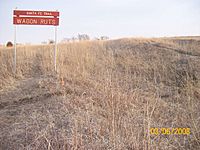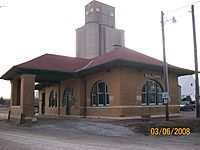Baldwin City, Kansas facts for kids
Quick facts for kids
Baldwin City, Kansas
|
||
|---|---|---|
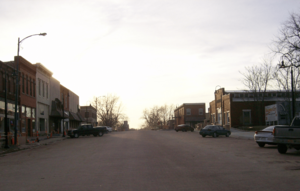
Downtown Baldwin City (2008)
|
||
|
||

Location within Douglas County and Kansas
|
||
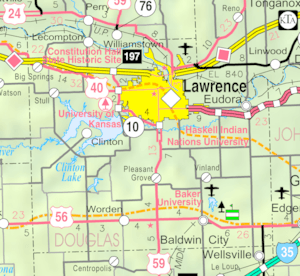
|
||
| Country | United States | |
| State | Kansas | |
| County | Douglas | |
| Founded | 1850s | |
| Incorporated | 1870 | |
| Named for | John Baldwin | |
| Area | ||
| • Total | 2.69 sq mi (6.96 km2) | |
| • Land | 2.67 sq mi (6.92 km2) | |
| • Water | 0.02 sq mi (0.04 km2) | |
| Elevation | 1,066 ft (325 m) | |
| Population
(2020)
|
||
| • Total | 4,826 | |
| • Density | 1,794/sq mi (693.4/km2) | |
| Time zone | UTC-6 (CST) | |
| • Summer (DST) | UTC-5 (CDT) | |
| ZIP code |
66006
|
|
| Area code | 785 | |
| FIPS code | 20-03900 | |
| GNIS ID | 2394055 | |
Baldwin City is a city in Douglas County, Kansas, in the United States. It is located about 12 miles (19 km) south of Lawrence. In 2020, about 4,826 people lived in Baldwin City. The city is also home to Baker University, which is the oldest four-year university in Kansas.
Contents
History of Baldwin City
How Baldwin City Started
Baldwin City began as a stop along the famous Santa Fe Trail. This trail was a busy route for trade and travel across the American West. The small community was first called Palmyra. It had basic shops like a harness shop, a blacksmith, and a hotel.
In 1858, a group of Methodist ministers met at a place called Kibbee Cabin. They decided to start Baker University there. Palmyra bought land to the south for the new university and the town around it. The first post office opened in June 1857.
The town was named after John Baldwin, who helped the community a lot. He built a saw mill, which was important for building homes and businesses. Baldwin City officially became a city on September 22, 1870.
Events Around the Civil War
Baldwin City was in an area where important events happened before the American Civil War. Just three miles east of Baldwin, a fight called the Battle of Black Jack took place on June 2, 1856. This battle involved John Brown, a famous abolitionist.
Later, in 1863, a group called Quantrill's raiders passed very close to Baldwin City. This happened after they had attacked and burned the nearby city of Lawrence.
Midland Railway Trains
In 1867, the first railroad tracks south of the Kansas River were built through the area. In 1906, the Santa Fe Depot was built. Today, the Midland Railway offers fun train rides. These trips go for over 20 miles (32 km) to towns like Ottawa and Norwood.
The Midland Railway also has a special program for Scouts. It's one of the few places where Scouts can earn a railroading merit badge. They have even hosted events with Thomas the Tank Engine!
Maple Leaf Festival Fun
Every year since 1957, Baldwin City has hosted the Maple Leaf Festival. It takes place during the third full weekend in October. The festival started as a way to celebrate a good harvest and enjoy the beautiful fall leaves.
Today, it is a very popular fall event for families in the area. It includes a parade, arts and crafts, a quilt show, plays, history tours, train rides, and live music. More than 30,000 people visit the festival each year!
Geography and Climate
Baldwin City covers an area of about 2.64 square miles (6.84 km2). Most of this area is land, with a small amount of water.
Weather in Baldwin City
The weather in Baldwin City has hot and humid summers. The winters are usually cool to cold. This type of weather is known as a humid subtropical climate.
Population Information
| Historical population | |||
|---|---|---|---|
| Census | Pop. | %± | |
| 1880 | 325 | — | |
| 1890 | 935 | 187.7% | |
| 1900 | 1,017 | 8.8% | |
| 1910 | 1,386 | 36.3% | |
| 1920 | 1,137 | −18.0% | |
| 1930 | 1,127 | −0.9% | |
| 1940 | 1,096 | −2.8% | |
| 1950 | 1,741 | 58.9% | |
| 1960 | 1,877 | 7.8% | |
| 1970 | 2,520 | 34.3% | |
| 1980 | 2,829 | 12.3% | |
| 1990 | 2,961 | 4.7% | |
| 2000 | 3,400 | 14.8% | |
| 2010 | 4,515 | 32.8% | |
| 2020 | 4,826 | 6.9% | |
| U.S. Decennial Census | |||
Baldwin City is part of the larger Lawrence area.
People in Baldwin City (2020)
In 2020, there were 4,826 people living in Baldwin City. Most of the people were white. There were also people of African American, Native American, Asian, and other backgrounds. Some people identified with two or more races. About 4% of the population was Hispanic or Latino.
The average age of people in the city was about 31.5 years old. About 22% of the population was under 18 years old.
Education in Baldwin City
Local Schools
The public schools in Baldwin City are part of the Baldwin City USD 348 school district. This district serves most of southern Douglas County. It has four schools in Baldwin City:
- Baldwin Elementary
- Baldwin Intermediate
- Baldwin Junior High
- Baldwin High School
The high school's sports teams are called the Bulldogs.
Baker University
Baldwin City is home to the main campus of Baker University. This is a liberal arts university that was started in 1858 by Methodist ministers. It is the oldest four-year university in Kansas. Baker University has always allowed both boys and girls to attend.
Notable People
- Delia L. Weatherby (1843—1916), a writer and supporter of the temperance movement.
Gallery
See also
 In Spanish: Baldwin City (Kansas) para niños
In Spanish: Baldwin City (Kansas) para niños



